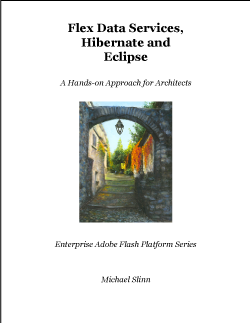Time to read: 3 minutes.

ISBN 978-0-9842789-0-9
Published September, 2010.
505 pages.
No longer available.
View the table of contents.
About This Book
This book explains how to design, build and test the Flex Data Services and the server-side Java stack of an application built with the Adobe Flash Platform. Java EE technology such as Tomcat and Hibernate are covered in detail, including reverse engineering ORM POJOs from a database schema, and creating a schema from POJOs. Using the tools and techniques described in this book series, one or two people can put together a client-server system that would have required at least a dozen people ten years ago, in a similar amount of time. What’s more, the software stack described in this book can support tens of thousands of simultaneous users per server CPU, with excellent responsiveness, high reliability and presentation-quality graphics.
Learn about how to use narrowcasting using BlazeDS, a valuable technique that streams data to specific clients.

This book also describes a simple and effective technique for dynamic endpoints, so a single Flex SWF can be deployed to any server without recompilation. Example projects are provided with the book.
Because access to remote data sources is part of many applications, the free open source BlazeDS package is discussed with working code examples, as well as its big brother, LiveCycle DS and selected features of GraniteDS. This book also covers Hibernate, an object-relational mapping technology and shows how it works with databases, including reverse engineering ORM POJOs from a database schema, and creating a schema from POJOs.
The book has many working example projects, consisting of a mixture of Java code, XML, SQL and ActionScript code. JUnit 4 and FlexUnit are used to demonstrate concepts.
Target Audience
Flex Data Services, Hibernate and Eclipse is intended for experienced architects and programmers who would like to design and implement non-trivial applications using the Adobe Flash Platform using a Java EE back end.
If you need to use BlazeDS or LiveCycle to access remote resources from a Flex or AIR application, and efficiently handle a database using Hibernate, then Flex Data Services, Hibernate and Eclipse is for you.
You should be able to make a “Hello, World!” Flex application before reading this book. There is no need to be a Flex expert. Although you should know Eclipse and Java, have a passing knowledge of Java Annotations (introduced in JDK 1.5) and understand Java servlet engines, no prior experience with BlazeDS, LiveCyle or Hibernate is assumed.
Did You Know?
Adobe's documentation and most other Flex books tell you to set up your Flex project using a fixed endpoint. Unfortunately, doing this compiles the deployment URL into the code, necessitating an edit and recompile for deployment to each of testing, staging and production servers.
A single instance of LiveCycle DS can support 50,000 simultaneous users.
One of the principal use cases for the LiveCycle DS’s Data Management Service is to synchronize occasionally connected Adobe AIR applications.
It would require a significant amount of work to design a similar feature using BlazeDS. Learn how to use this feature by studying example projects provided with the book.
Hibernate can be exposed to Flex clients through 'assemblers', for designs that have very little server-side logic; alternatively Hibernate can be shielded from the client using a service layer.














